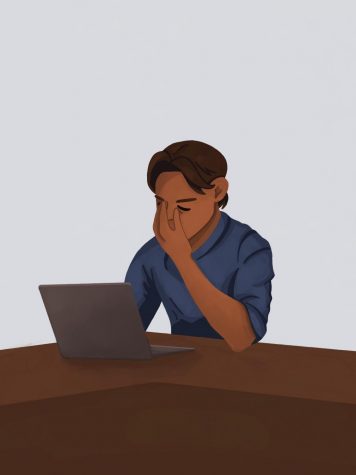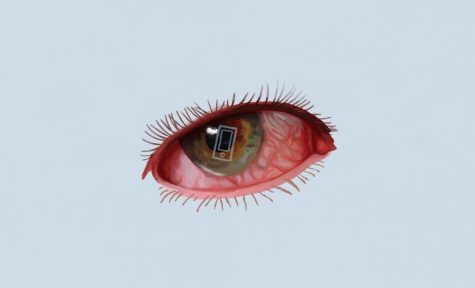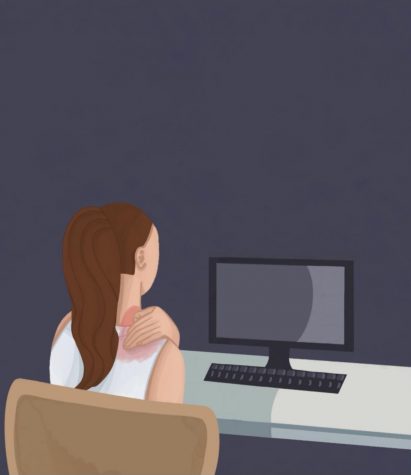Know the symptoms: Zoom fatigue
Increased screen time, hours spent sitting, and isolation. Three RUHS students recount the physical effects of distance learning and their solutions.
I.
Zoom fatigue has many wishing they can just call a life-line and go back to the days of walking up and down the crowded and often crazy school hallways. For sophomore Ben Nguyen, the physical strains of Zoom classes and increased screen time have been a struggle.
“Sitting in a chair staring at a screen for so long is tough. Sometimes I’ll start slouching in class and then for the next few days, I will feel it in my back and neck. I am constantly reminding myself to try and sit up straight, but it is still hard,” Nguyen said.

Nguyen believes taking advantage of breaktime and “stretching and standing up has improved different back and neck aches through Zoom classes.”
“Sometimes in between classes or during a break I’ll just go walk around the room or the house. I just try to do something to stay somewhat active when I am on a break even if it is just standing up for a second,” Nguyen said.
Due to the pandemic, Nguyen has also found himself communicating with friends virtually, which increases the amount of time he spends looking at a screen.
“Since we are social distancing, I don’t really see my friends much. Playing video games has been a great way for me to connect and talk to my friends. But, that also just increases the number of hours I am staring at a screen. I definitely feel my eyes start to hurt at the end of the day and feel myself getting more and more tired,” Nguyen said.
Nguyen believes the key to succeeding during the distance learning process is primarily caring for our own physical and mental health needs first.
“We are living in a super strange time and I think the best thing we can do for ourselves is to just take care of ourselves. I think that Zoom fatigue is real and by acknowledging the need for screen breaks, we are taking small steps to help ourselves during this time,” Nguyen said. —JESS ALVEAR
II.
Due to the excessive amount of time spent staring at a screen and sitting in one place, many students have struggled with body aches during distance learning. For sophomore Alexis Battin, back pain, neck pain and eye strains are daily problems she struggles to overcome.
Due to having worn glasses for many years and her tendency to use electronics a lot, Battin already experienced eye strain, but distance learning has made it even worse. The increase in time spent sitting has also led to her starting to develop constant neck pain and occasional back pain.
“Before distance learning my eye strain was already bad since I was on my phone so much. Now it’s unfortunately gotten even worse and more frequent,” Battin said.

To deal with her pain, Battin takes some precautions to improve her condition. However, she has to do different activities to ease pains in different areas.
“For my back and neck pain, I find that just going for a walk or doing some type of exercise or stretching helps. To deal with eye strain, after school, I try and get outside or take a nap, but it can be difficult with all of the work I have to do,” Battin said.
With the prospect of switching to the hybrid model of learning, Battin hopes that the reduced amount of time spent staring at a screen will help ease her pain.
“I think hybrid learning will help with these problems because it will allow me to not look at screens as much and to get some exercise. I would definitely love to go back to school full time, but it’s not safe right now. In the meantime, I hope to find effective solutions to overcome these problems,” Battin said. —SARA MIYAKE-SINGER
III.
While online learning can be a pain in the back, quite literally, there are many alternative learning styles that can improve any physical strains that you may be having.
Sophomore Ari Anderson has faced a mix of physical struggles due to the constant online learning.
As we are well into the school year and the number of assignments and tests has increased, the time spent typing and writing has increased as well, causing painful hand cramps that students must suffer through as they complete their assignments.

“One of the biggest physical struggles for me is that I’ve been typing so much, so when I have to write for a class, my hand easily cramps,” Anderson said.
In the beginning of the school year, Anderson began using a yoga ball while in class. The yoga ball would ensure that she “never felt sore after the school day.” However, as the school year has gone on, Anderson has noticed that the yoga ball does more for her than just prevent her from getting sore.
“It helps me pay more attention in class,” Anderson said.
According to a study done by the Mayo Clinic, it is proven that the use of ball chairs and movement while learning improves students’ attentiveness and posture in addition to limiting back pain, keeping students focused on their schoolwork.
As this year is one like none other, staying focused and motivated towards distance has been a struggle for many students when it comes to completing schoolwork.
“I think it’s more important than ever to stay motivated during online school, since it’s so much different than regular school and you don’t have the same incentives as you did before, ” Anderson said. —MIA SCHRIFT

Heyyy! My name is Jess Alvear and this is my third year on staff and my first year as a sports editor! In my free time, you can catch me playing softball and watching The Bachelor. I am so excited to continue...

I hope to be successful enough so that one day future AP Lang students will have to analyze whatever I say.
Hi! My name is Mia. I'm a senior and this is my fourth year as a High Tide staff member. Some of my favorite things include reading, writing, and hanging out with my friends.


